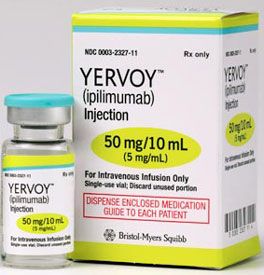Ipilimumab's Unique Side Effects Require Unique Management
Researchers at SFOA have examined the challenges ipilimumab's unique side-effect profile presents to oncology professionals

The FDA recently approved the immunotherapy ipilimumab (Yervoy) as a second-line treatment for patients with metastatic melanoma. Researchers at San Francisco Oncology Associates (SFOA) have examined the challenges the medication’s unique side-effect profile presents to oncology professionals. The SFOA group discussed its research at the 36th Annual Oncology Nursing Society Congress, which took place in Boston, Massachusetts, from April 28 to May 1.
Ipilimumab’s mechanism of action leads to a unique set of side effects. “Ipilimumab [uses] a patient’s immune system to go after the cancer, [so] it can affect other organs in the body,” according to lead researcher Dana Monroe, RN, BSN. “[Ipilimumab] is very unlike chemotherapy in [regard to] any of the things that…[are usually being] dealt with in the infusion room,” Monroe added.
Ipilimumab treatment can affect cells in the skin, gastrointestinal system, and liver. The most common side effects (occurring in ≥5% of patients) include fatigue, diarrhea, pruritus, rash, and colitis. In some cases, it can also affect liver cells and cause hepatitis.
Grade 1/2 adverse reactions can often be managed with over-the-counter treatments and dietary adjustments. Grade 2 diarrhea/colitis requires corticosteroids, such as prednisone, asacol, or budesonide. Most Grade 3/4 side effects may necessitate interruption or cessation of treatment and the use of steroids to avoid potentially fatal outcomes.
Although ipilimumab treatment can cause serious toxicities, most can be controlled through early reporting by patients and proper adherence to management protocols by the oncology team. The SFOA research group’s program for successfully managing ipilimumab therapy stressed increased education for both the oncology team and patients.
For example, oncology professionals need to familiarize themselves with the symptoms and management of ipilimumab’s side effects to facilitate early diagnosis and treatment. Patients must also be made aware of ipilimumab’s unique side effects to foster early recognition and reporting. “[Because] it is the immune system causing [the side effects], it is not just a matter of a drug clearing out of [their] system…so you have to intervene right away,” said Monroe.
To facilitate patient education, the researchers created a checklist of side effect symptoms and treatments that the oncology team can review with patients.
Immunotherapies are new to both oncology professionals and patients. The experience at SFOA has shown that as these treatments become available, oncologists, nurses, and patients must work together to ensure successful treatment with these novel therapeutics.



